Like a lab rat who can’t shake his cocaine addiction, I mercilessly bashed my Power-Up Wristband™ against a golden question mark block to hear that familiar Mario coin sound. Joined by photographer Iwan Baan, who looked on in curious but loving horror, I bathed in the dopamine fountain of nostalgic immersion.
Super Nintendo World™ at Universal Studios Hollywood isn’t just a new theme park in Los Angeles. It is a time machine that transported me to my basement circa 1993. Upon entry, memories of tightened jaws, sweaty palms, and sugary beverages consumed while passing the controller back and forth with my sister sprang forth. Back then, the air was filled with 16-bit music and feral screams which only abated when Mom’s magic words echoed from upstairs, proclaiming “dinner is ready!”
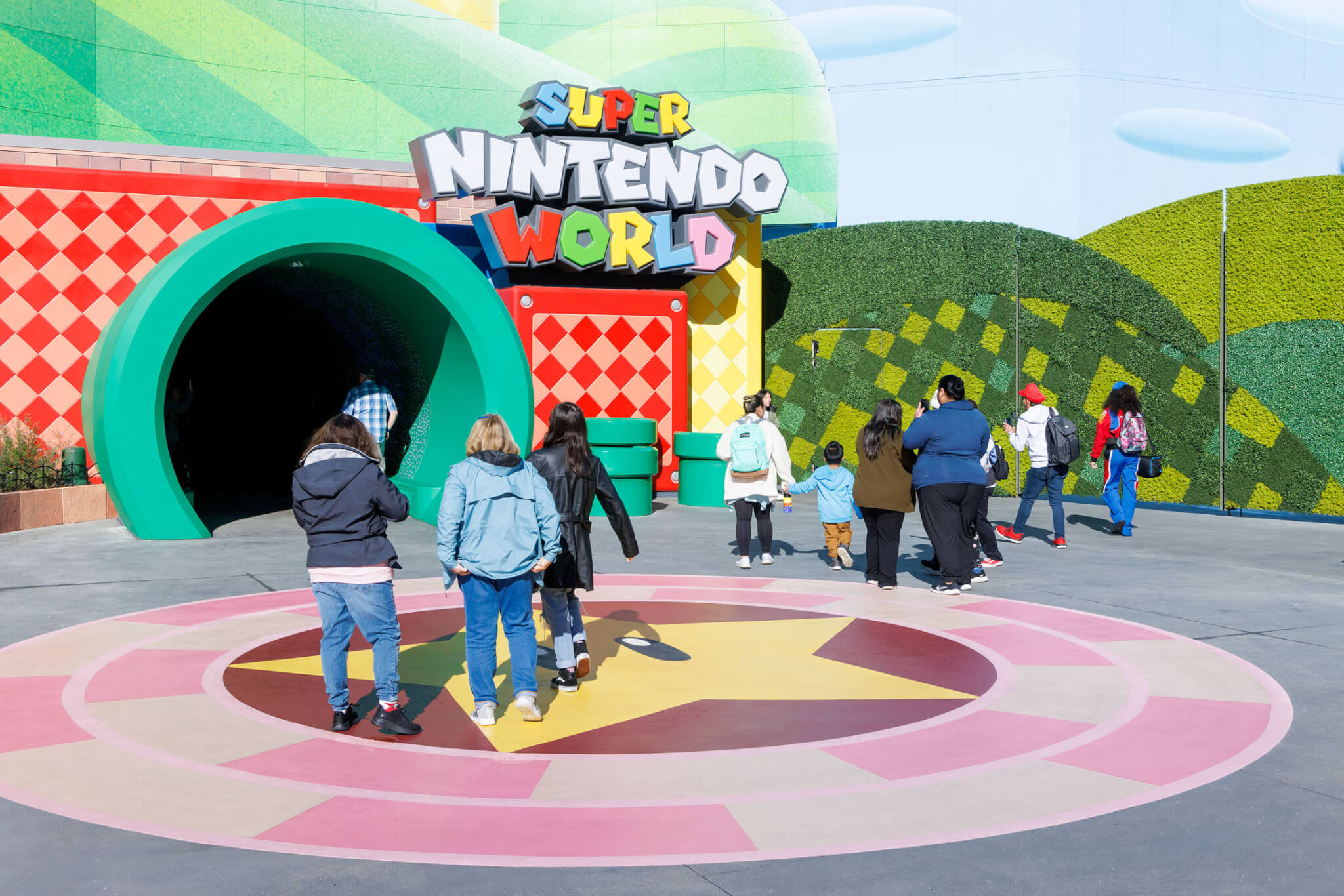
Those are my personal memories, but the collective memory of safe, domestic leisure space is an important aspect of contemporary gaming. It has been physically deployed to create an immersive theme park environment which invites investigation as a space for architectural inquiry. Super Nintendo World™ reveals shocking advances in ideas of flatness, nostalgia, worldbuilding, and their evil cousin: gamification.
Super Nintendo World™ opened to the public in February. It was realized by a partnership between Nintendo® and Universal Creative and in collaboration with Mario creator Shigeru Miyamoto. Most realms in Universal Studios blend together so that a casual stroll consists of popping in and out of them at regular intervals. In short order I can face Moe’s Pub from The Simpsons, gaze up at Hogwarts Castle, and appreciate Gru’s House down the street. Yet Super Nintendo World™ is barricaded into a synthetic gully with high walls that extend up to block views of the rest of the theme park itself and the surrounding California mountains. The entrance to the area is a bright green steel tube known to Mario fans as a warp pipe, though here it is set horizontally, not vertically. After emerging from its shadow, a visual feast unfolds.
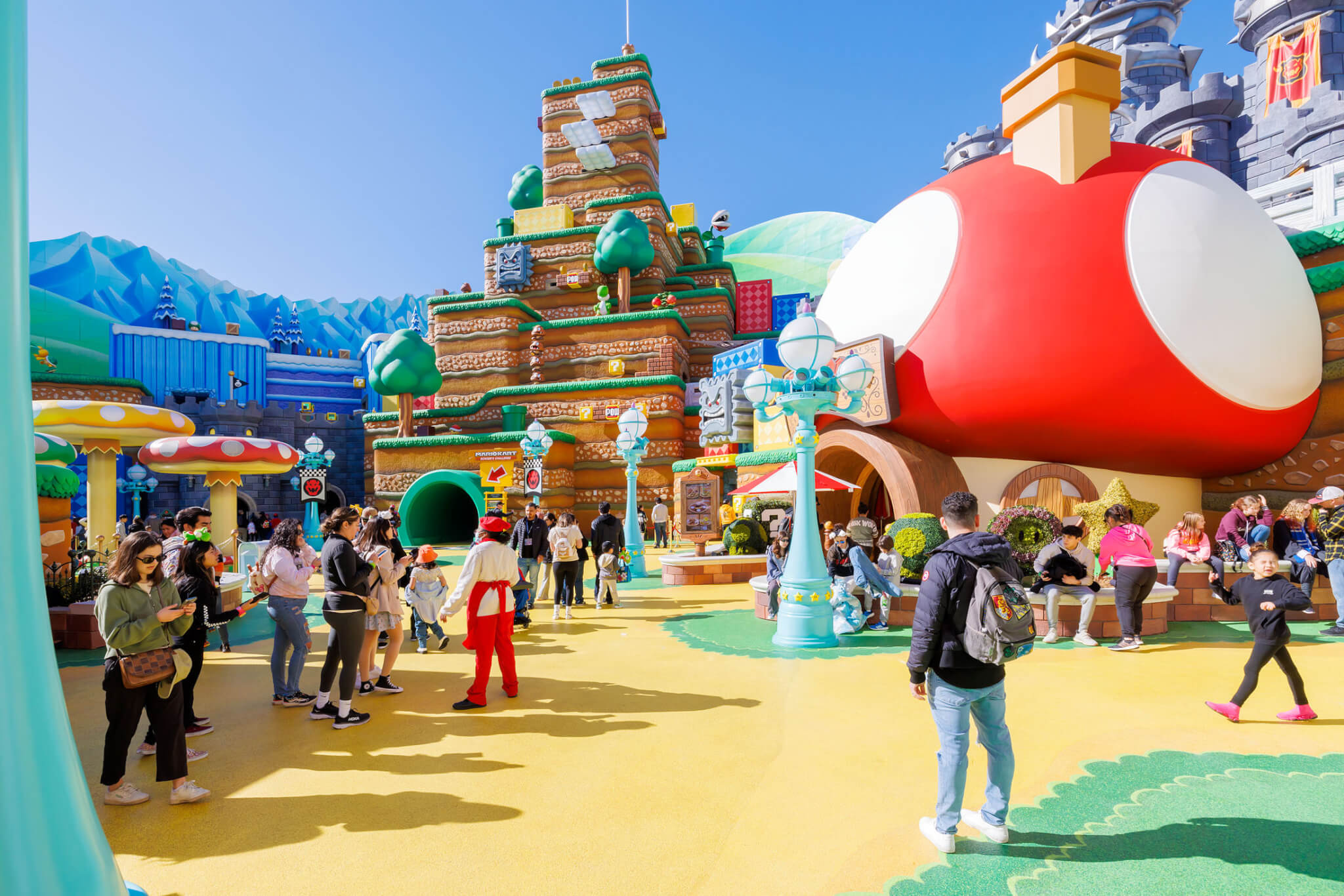
Flatness is a key design technique used masterfully to achieve complex visual immersion on such a small site. Bowser’s Castle, Cool Cool Mountain, Princess Peach’s Castle, Dry Dry Desert, and Toadstool Cafe (which function as storefronts lining a central, mushroom-themed seating area) are all woven together through a series of suspiciously green hills. High, billboard-like walls of even flatter landscapes are staged between these lands. The architectural elements, painted to replicate low-resolution graphics, retain the shading from those original items which brings the cartoonish delight from screen to real space with photogenic effect. Animatronic characters from Super Mario like Goomba, Yoshi, and Koopa Troopa twist, bumble, and hop along the ledges in movement patterns familiar to the games, thereby multiplying the assumed depth.
Importantly, this flatness can be accessed and broken. The line for Bowser’s Challenge takes you up to an exterior balcony where the activities below can be observed, the mechanisms that power the characters examined, and views of the surrounding Hollywood Hills opened up. This instills a curiosity to find other such places. I located a staircase off the beaten path and headed skywards. Its summit revealed a small minigame area equipped with binoculars which visualize augmented reality interactions with the unaware guests below.

Nostalgia, of course, runs wild here. Mario was created in 1981 and has had many updates since the first appearance in Donkey Kong as a bundle of pixels vaguely resembling a mustached plumber. Piloting character design carefully through technological growth spurts over the next 40 years, Nintendo has doubled down on cartoonish cuteness rather than adding lifelike detail. Grateful as I am for the electrifying live-action 1993 Super Mario Bros. movie, there is an immediate correction to a fully animated reboot this year starring Chris Pratt as Mario and Jack Black as Bowser. Within the park, there is no throwback to older versions save for one secret spot which, when activated, illuminates the original Mario character in the middle of a brick wall for a short time before disappearing.
Importantly, it’s less the main characters but the levels as “worlds” which are developed and explored over time—the park guest becomes Mario. The realms retain essential climatic elements and are convincingly built-out with detailed environmental finishing: green pipes, layered earthen walls, faux wood finishes, etc. (The drawing set for this place must be insane.) Nostalgia for the game and the domestic leisure space it represents is embedded in all of these environments, in addition to the various versions of Nintendo’s characters and worlds. This may be one reason why the company is the most popular and most liked gaming brand in the United States. The park manages to create new memories on top of that nostalgia.
The pièce de résistance of worldbuilding in Super Nintendo World™ is a five-minute long, augmented-reality ride called Bowser’s Challenge, based on the popular video game Mario Kart. Launched in 1992, the series spans 14 different games across consoles, handheld devices, and mobile phones. It has sold 169.59 million copies in total, giving it the Guinness World Records title of Best Selling Racing Game. This is not just a ride but an interactive race that moves through iconic levels in the series and awards points for shooting shells at augmented-reality enemies.
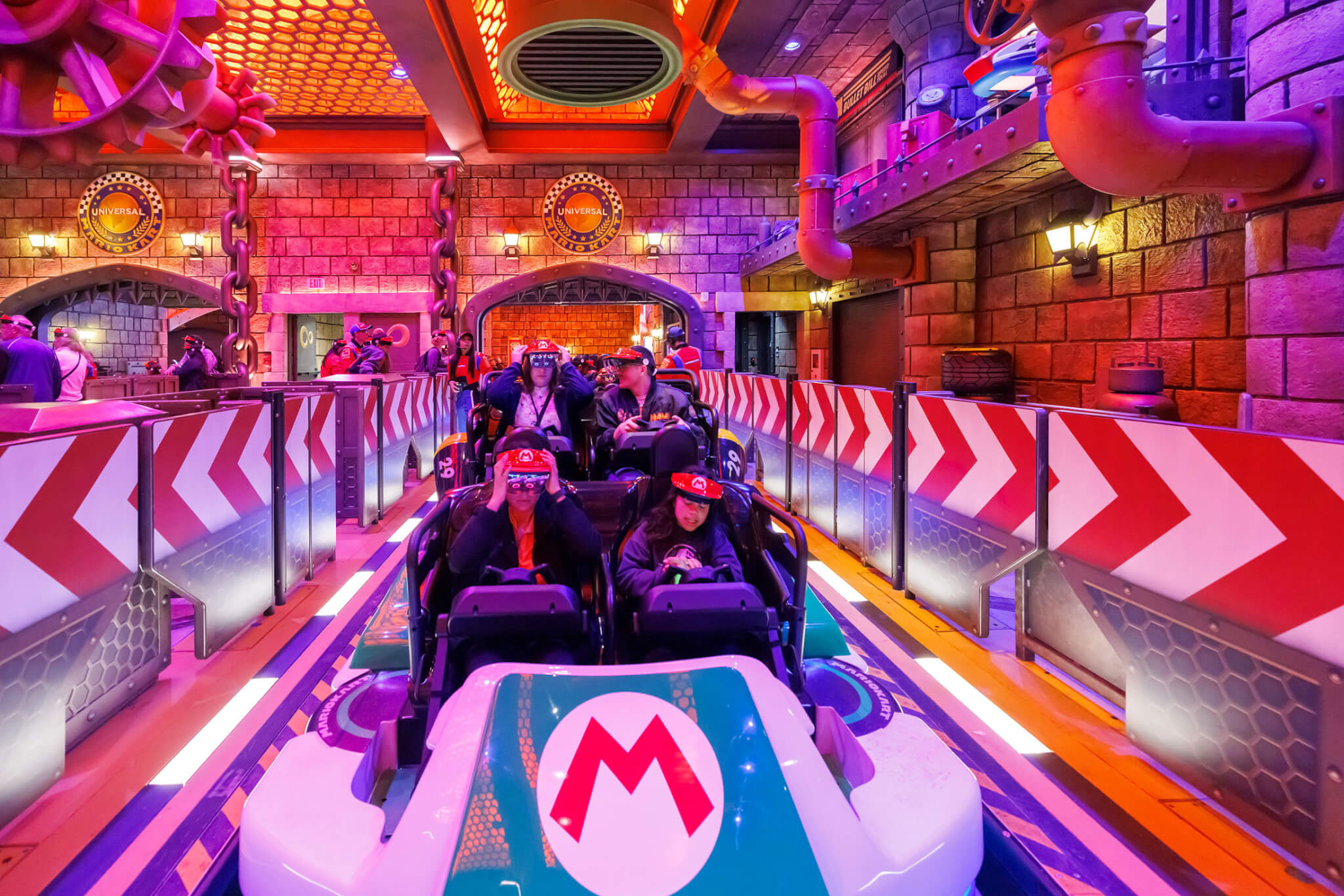
“3… 2… 1… Go!” The race kicked off in a familiar way. Baan and I launch from inside Bowser’s Castle, with gray stone block walls, huge chains, and a giant portcullis. Next we speed under the castle to find a swath of bright green plumbing pipes sporting an infestation of piranha plants. An underwater level follows—riders are puffed with a warm mist, expertly injecting a new sense into the equation—capped by a miniboss encounter with Fish Bone. Then we traverse a track first appearing nine years ago in Mario Kart 8 called Twisted Mansion, which achieves the most awe-inducing architectural detail of the whole park: A red-carpet path split down the middle by a banister which later twists up opposite sides of the walls like the bifurcated tongue of a fiendish serpent. This is followed by a zoom through a sky world and a desert world. The ride concludes with a trip down Mario Kart’s famous rainbow road.
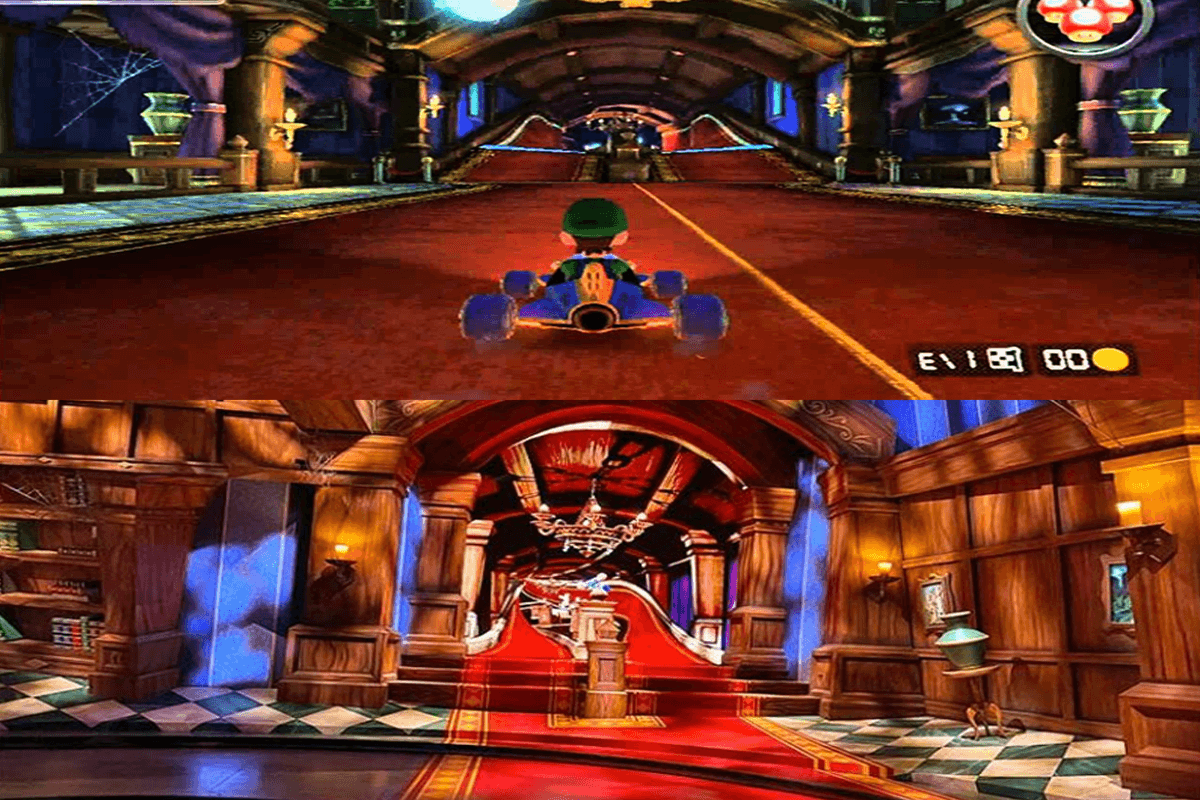
This magical place is plagued by gamification, a process set into motion by Miyamoto and the very first Mario games, which reward success with virtual coins. (“You are close to closing your rings for today!,” my iPhone nags. “Gamify your weight loss!,” a fitness app beckons me from my Instagram Ads. “You’ve earned 34 points with this purchase!,” the self-checkout machine exclaims.) The use of rewards and fake currency has been around since the inception of casino chips as a way to abstract real money into tokens. Super Nintendo World™ is overrun with the constant “ca-ching” of coins: Guests earn them while riding Bowser’s Challenge and through various interactive mini-games around the park. You can’t participate unless you purchase the otherwise useless $40 wristband, which allows you to join leaderboards and see rankings.
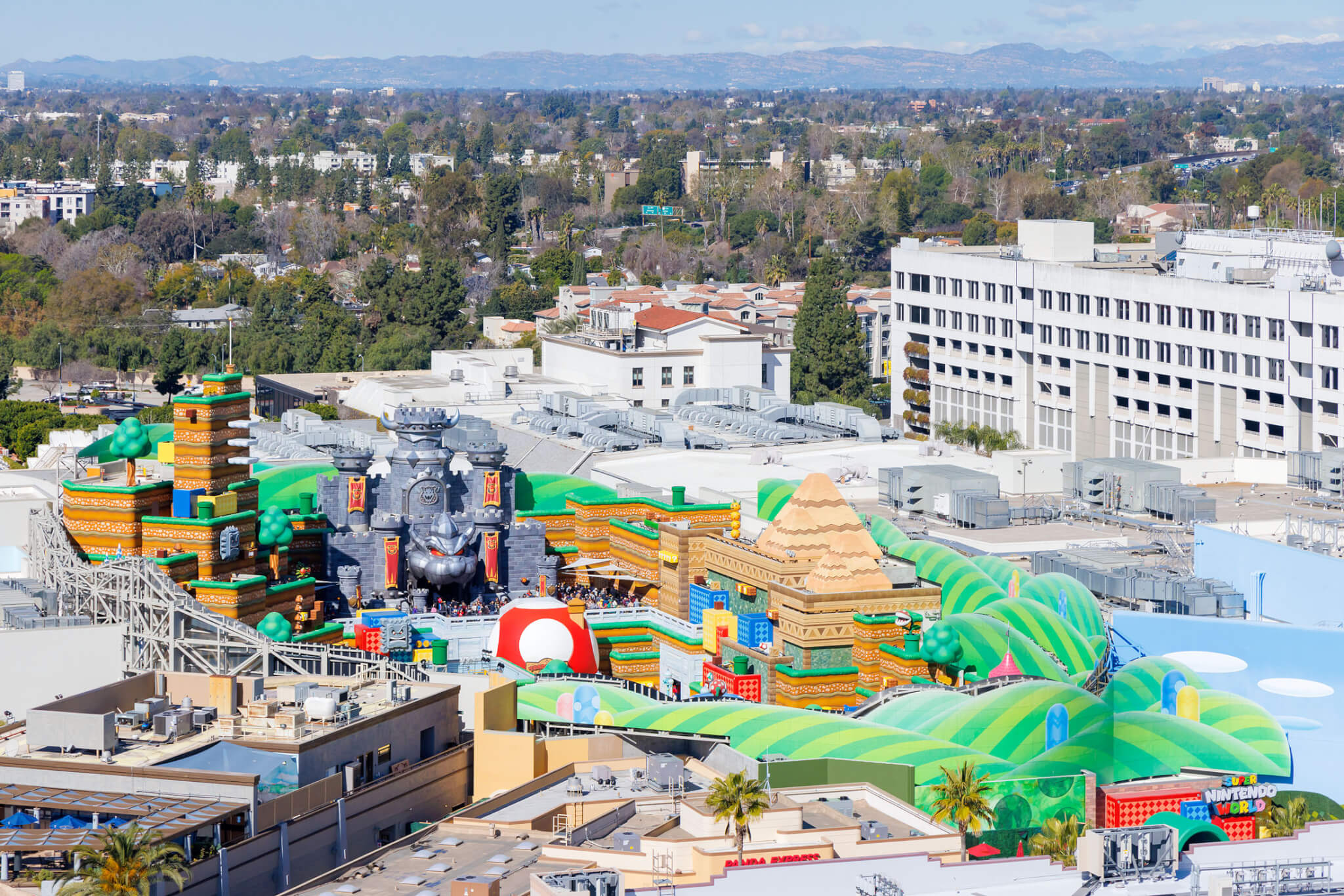
Theodore Adorno suggested that the re-enchantment of the world through aesthetic experience is also a re-enchantment of human purpose. Beyond revenue generation for Universal World and a potent brand experience for Nintendo, what is the purpose of Super Nintendo World™? I emerge from the warp pipe of nostalgia with a smile I can’t shake off my face. In Super Nintendo World™, architecture is a multidisciplinary tool that engages the imagination, resulting in a corporate monument to the power of our shared domestic leisure space. An enchanting experience, if you’ve got the coin.
Ryan Scavnicky is the founder of Extra Office, a design practice engaging media to uncover new channels for architectural content. He currently teaches architecture design, theory, and criticism at Kent State University.










